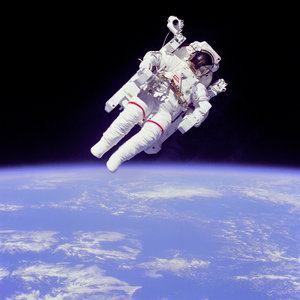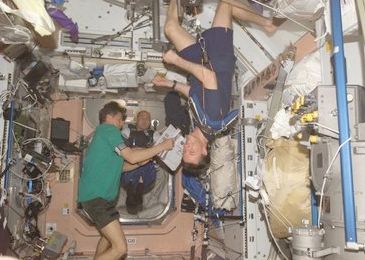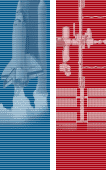|
|
|||||||||||||||||||||||||||||||||||||||||||||||||
|
HOME | BIOLOGY | FILMS | GEOGRAPHY | HISTORY | INDEX | INVESTORS | MUSIC | SOLAR BOATS | SPORT |
|||||||||||||||||||||||||||||||||||||||||||||||||
|
An astronaut, cosmonaut, spationaut or taikonaut (yuhangyuan) is a person who travels into space, or who makes a career of doing so. The criteria for determining who has achieved human space flight vary (see edge of space). In the United States, people who travel above an altitude of 50 miles (approximately 80 kilometers) are designated as astronauts. The FAI defines space flight as over 100 km (approximately 62 miles). As of July 26, 2005, a total of 445 humans had spent a total of over 28,000 crew-days in space including over 100 crew-days of space walks. 439 people qualify under the FAI definition. Those who have achieved this are said to hold astronaut wings. Astronauts from at least 34 countries have gone into space.
International variations
By convention, a space traveller employed by the Russian Aviation and Space Agency or its Soviet predecessor is called a cosmonaut. "Cosmonaut" is an anglicization of the Russian word космонавт (kosmonavt), which in turn derives from the Greek words kosmos, meaning "universe" and nautes, meaning "sailor".
In the USA, a space traveller is called an astronaut. The term derives of the Greek words ástron ("star") and nautes, ("sailor"). For the most part, "cosmonaut" and "astronaut" are synonyms in all languages, and the usage of choice is often dictated by political reasons. However in the United States, the term "astronaut" is typically applied to the individual as soon as training begins, while in Russia, an individual is not labeled a cosmonaut until successful space flight. On March 14, 1995 astronaut Norman Thagard became the first American to ride to space on-board a Russian launch vehicle, arguably becoming the first American cosmonaut in the process.
European (outside of the UK) space travellers are sometimes, especially in French-speaking countries, called spationauts (a hybrid word formed from the Latin spatium, "space", and Greek nautes, "sailor"). While Europe has not yet produced manned spaceships, it has sent men and women into space in cooperation with the Soviet Union, and, to a lesser extent, the United States of America.
Taikonaut is sometimes used in English for astronauts from China by Western news media. The term was coined in May 1998 by Chiew Lee Yih from Malaysia, who used it first in newsgroups. Almost simultaneously, Chen Lan coined it for use in the Western media based on the term tŕikōng (太空), Chinese for space. In Chinese itself, however, a single term yǔháng yuán (宇航員, "universe navigator") has long been used for astronauts and cosmonauts. The closest term using taikong is a colloquialism tŕikōng rén (太空人, "space human") which refers to people who have actually been in space. Official English text issued by the Chinese government uses astronaut.
Astronauts on the International Space Station Space milestones
The first cosmonaut was Yuri Gagarin, who was launched into space on April 12, 1961 aboard Vostok 1. The first woman cosmonaut was Valentina Tereshkova, launched into space in June 1963 aboard Vostok 6. Alan Shepard became the first American in space in May 1961. Vladimir Remek became the first non-Soviet European in space in 1978 on a Russian Soyuz rocket. On July 23, 1980 Pham Tuan of Vietnam became the first Asian in space when he flew aboard Soyuz 37. On October 15, 2003 Yang Liwei became China's first astronaut on the Shenzhou 5 spacecraft.
The youngest person to fly in space is Gherman Titov, who was roughly 26 years old when he flew Vostok 2, and the oldest is John Glenn who was 77 when he flew on STS-95. The longest stay in space was 438 days by Valeri Polyakov. As of 2005, the most spaceflights by an individual astronaut was seven, a record held by both Jerry L. Ross and Franklin Chang-Diaz. The furthest distance from Earth an astronaut has traveled was 401,056 km (during the Apollo 13 emergency).
The first non-governmental astronaut was Christa McAuliffe, who was killed during the Space Shuttle Challenger disaster on January 28, 1986. The first astronaut to fly a privately-funded mission was Mike Melvill, on SpaceShipOne flight 15P. This should be contrasted with the various millionaire space tourists, who have flown as passengers, or minor crew members, on publicly funded flights (generally Russian resupply flights to the ISS). The first space tourist was Dennis Tito on April 28, 2001.
In the United States, persons selected as astronaut candidates receive silver Astronaut wings. Once they have flown in space they receive gold Astronaut wings. The United States Air Force also presents Astronaut wings to its pilots who exceed 50 miles in altitude.
International astronauts
Up until the end of the 1970s only Americans and Soviets were active astronauts. In 1976 the Soviets started the Intercosmos program with a first group of 6 cosmonauts from fellow socialist countries, a second group started training in 1978. At about the same time in 1978 the European Space Agency selected 4 astronauts to train for the first Spacelab mission on board of the Space Shuttle. In 1980 France started their own selection of astronauts, followed in 1982 by Germany, in 1983 by the Canadian space program, in 1985 by Japan and Italy in 1988. Several more international payload specialist were selected for the Space Shuttle, and also later for international Soyuz missions of Russia. In 1998 the European Space Agency formed a single astronaut corps of 18 by dissolving the former national corps of France, Germany and Italy.
Astronaut training
The first astronauts, both in the USA and USSR, tended to be jet fighter pilots, often test pilots, from military backgrounds. U.S. military astronauts receive a special qualification badge, known as the Astronaut Badge upon completion of Astronaut training and participation in a space flight..
Astronaut deaths
So far, eighteen astronauts have been killed on space missions, and at least ten more have been killed in training accidents on the ground. See also: space disaster.
LINKS:
Biographical Data
Public AppearancesInformation About Becoming an Astronaut
Living and Working in SpaceNASA Human Spaceflight Program Resources
ASTRONAUTICS HISTORY
Key Documents in the History of Space Policy
NASA Human Spaceflight Programs
Major NASA Planetary Probes
Major NASA Lunar Probes
Major NASA Applications Satellites and Earth Observation Projects
Communications Satellite History
Earth Resources Monitoring History
Weather Satellites
The NASA History Program
AVIATION A - Z
A taste for adventure capitalists
This page is sponsored by Solar Cola
|
|||||||||||||||||||||||||||||||||||||||||||||||||
|
This
website
is Copyright © 1999 & 2013 NJK. The bird |
|||||||||||||||||||||||||||||||||||||||||||||||||
|
AUTOMOTIVE | BLUEBIRD | ELECTRIC CARS | ELECTRIC CYCLES | SOLAR CARS |
|||||||||||||||||||||||||||||||||||||||||||||||||








